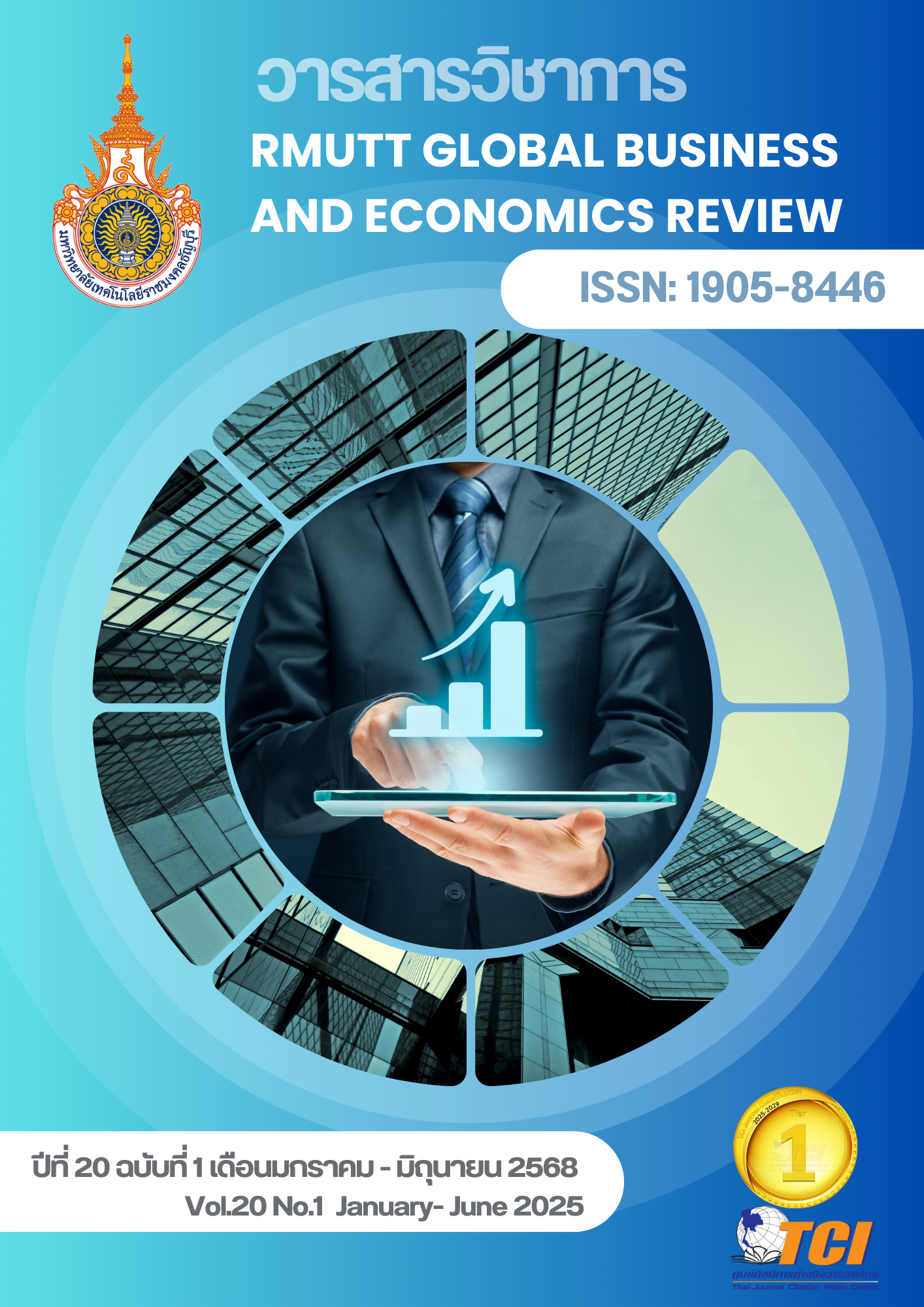THE ASSESSMENT TO COMPARED THE CARBON FOOTPRINT OF LAND TRANSPORTATION BETWEEN THE SITUATION BEFORE AND UNDER SITUATION COVID-19 PANDEMIC TO THE CONCEPT GREEN LOGISTIC: A CASE STUDY OF HIGHWAYS OF BANGKOK
DOI:
https://doi.org/10.60101/rmuttgber.2025.279500Keywords:
Carbon Footprint, Carbon Dioxide , Green Logistics , Covid19 , SustainabilityAbstract
A research study has been assessed to compare the carbon footprint of land transportation before and during the COVID-19 pandemic with the Concept Green Logistic A case study of Highways of Bangkok. The objective was to examine the carbon footprint of the land transport sector in both scenarios and propose an effective management approach for environmentally friendly cargo based on the Green Logistics concept. In the comparative analysis of the carbon footprint of land transportation before and during the COVID-19 pandemic, T-Test statistics were employed with a confidence level of 95% and a significance level of 0.05. The Carbon Footprint Assessment Model used a Cradle-to-Gate or Business-to-Business (B2B) approach. The results revealed a significant difference in the average amount of carbon dioxide emissions in the land transportation sector for cargo trucks before and during the COVID-19 pandemic. Interestingly, the pandemic situation did not appear to have a substantial impact on the land transportation system of the truck group in the Bangkok highway case study. An effective method to reduce greenhouse gas emissions involves transitioning to clean energy vehicles, with Battery Electric Vehicles (BEV) Another option for creating sustainability and reducing environmental impact today.
References
กรมการขนส่งทางบก. (2563). รายงานสถิติการขนส่งประจำปี. สืบค้นจาก https://www.web.dlt.go.th/statistics/
กรมทางหลวง. (2556). ประเภทรถที่ใช้ในการสำรวจปริมาณการจราจร. สืบค้นจาก https://www.tims.doh.go.th/sites/default/files/ประเภทรถที่ใช้ในการสำรวจปริมาณการจราจร.pdf.
กรุงเทพมหานคร และ คณะผู้เชี่ยวชาญ JICA. (2563). แผนแม่บทกรุงเทพมหานครว่าด้วยการเปลี่ยนแปลงสภาพภูมิอากาศ พ.ศ. 2556-2566. สืบค้นจาก https://webportal.bangkok.go.th/environmental/page/sub/14078/
ธนาคารทหารไทย. (2565). โอกาสต่อยอดของธุรกิจ SME เมื่อเข้าสู่ยุครถยนต์พลังงานไฟฟ้า. ธนาคารทหารไทย. สืบค้นจาก https://www.ttbbank.com/th/fin-biz/industry-expertise/other-industries/industry-evcar22
ธนันธร มหาพรประจักษ์. (2563). ปรับธุรกิจของคุณให้อยู่รอดในยุคปกติใหม่. ธนาคารแห่งประเทศไทย. สืบค้นจาก https://www.bot.or.th/Thai/ResearchAndPublications/articles/Pages/Article19Oct2020.aspx
นนทวรรณ พิทักษ์วินัย, และ ศุภิสรา จินดามณี. (2560). การประเมินการปล่อยก๊าซเรือนกระจกและความต้องการใช้พลังงานเชื้อเพลิงฟอสซิลตลอดวัฏจักร ชีวิตของผลิตภัณฑ์ไอศกรีมกะทิ: กรณีศึกษาโรงงานผลิตไอศกรีม จังหวัดแพร่. ภาควิชาวิศวกรรมอุตสาหการ คณะวิศวกรรมศาสตร์ มหาวิทยาลัยนเรศวร.
นุสรา เงินเจริญ. (2565). สอท. เผยยอดยานยนต์ไฟฟ้าในเดือนธันวาคม 2565 เติบโตเพิ่มขึ้น. Autoinfo. สืบค้นจาก https://www.autoinfo.co.th/online/438773/
สมชาย โอตป์ฉิมพลี. (2566). ปริมาณการปล่อยก๊าซเรือนกระจกจากการให้บริการรถขนส่งมวลชน: กรณี ศึกษามหาวิทยาลัยสงขลานครินทร์ วิทยาเขตหาดใหญ่. เอกสารประกอบการประชุมวิศวกรรมโยธาแห่งชาติ ครั้งที่ 28, เรื่องความท้าทายด้านวิศวกรรมโยธาหลังการระบาดใหญ่, ภูเก็ต, ประเทศไทย. สืบค้นจาก https://conference.thaince.org/index.php/ncce28/article/view/1978/1420
สำนักอำนวยความปลอดภัยกรมทางหลวง. (2564). ปริมาณจราจรบนทางหลวงสายหลักทั่วประเทศ กรมทางหลวง. สืบค้นจาก http://bhs.doh.go.th/download/traffic
สำนักงานสภานโยบายการอุดมศึกษา วิทยาศาสตร์ วิจัยและนวัตกรรมแห่งชาติ, (2564). SDGs คืออะไร มารู้จัก 5 เป้าหมายแรกจากมิติสังคม. สืบค้นจาก https://www.nxpo.or.th/th/8081/
สำนักงานสภาพัฒนาเศรษฐกิจแห่งชาติและสังคมแห่งชาติ. (2564). ประเทศไทยและเป้าหมายการพัฒนาที่ยั่งยืน. สืบค้นจาก https://sdgs.nesdc.go.th
สุวิน อภิชาตพัฒนศิริ. (2556). การจัดทำคาร์บอนฟุตพริ้นท์ขององค์กร. สืบค้นจาก https://www.si.mahidol.ac.th/th/division/faci.envi/admin/download_files/10_93_1d9Vj9X.pdf
สำนักงานสภาพัฒนาเศรษฐกิจและสังคมแห่งชาติ. (2564). ประเทศไทยและเป้าหมายการพัฒนาที่ยั่งยืน. สำนักงานสภาพัฒนาเศรษฐกิจและสังคมแห่งชาติ. สืบค้นจาก https://sdgs.nesdc.go.th
ออโต้อินโฟ. (2565). BEV ในภาคขนส่งประหยัดกว่าหรือสิ้นเปลืองกว่ากัน รถยนต์เครื่องยนต์ดีเซล. สืบค้นจาก https://www.autoinfo.co.th/article/400742/
องค์การบริหารจัดการก๊าซเรือนกระจก (องค์การมหาชน). (2563). ข้อกำหนดและแนวทางการคำนวณคาร์บอนฟุตพริ้นท์ของผลิตภัณฑ์. สืบค้นจาก https://thaicarbonlabel.tgo.or.th/index.php?lang=TH&mod=Y0hKdlpIVmpkSE5mWkc5M2JteHZZV1E9
องค์การบริหารจัดการก๊าซเรือนกระจก (องค์การมหาชน). (2567). T-VER คืออะไร. สืบค้นจาก https://ghgreduction.Tgo.or.th/th/about-tver/t-ver.html
องค์การบริหารจัดการก๊าซเรือนกระจก (องค์การมหาชน).(2561) . คู่มือการคํานวณปริมาณการลดก๊าซเรือนกระจกสําหรับโครงการภาคพลังงาน และของเสีย. สืบค้นจาก http://conference.tgo.or.th/download/tgo_or_th/Article/2018/GHG_Reduciton.pdf.
Demircan Çakar, N., Gedikli, A., Erdoğan, S., & Yıldırım, D. Ç. (2021). A comparative analysis of the relationship between innovation and transport sector carbon emissions in developed and developing Mediterranean countries. Environmental Science and Pollution Research, 28(33), 45693–45713. https://doi.org/10.1007/s11356-021-13390-y
Rives, J., Fernández-Rodríguez, I., Rieradevall, J., & Gabarrell, X. (2012). Environmental analysis of the production of champagne cork stoppers. Journal of Cleaner Production, 25, 1–13. https://doi.org/1016/j.jclepro.2011.12.001
Du, H., Chen, Z., Peng, B., Southworth, F., Ma, S., & Wang, Y. (2019). What drives CO2 emissions from the transport sector? A linkage analysis. Energy, 175, 195–204. https://doi.org/10.1016/j.energy.2019.03.052
Gao, Z., Lin, Z., & Franzese, O. (2017). Energy Consumption and Cost Savings of Truck Electrification for Heavy-Duty Vehicle Applications. Transportation Research Record: Journal of the Transportation Research Board, 2628(1), 99–109. https://doi.org/10. 3141/2628-11
Georgatzi VV, Stamboulis Y, Vetsikas A. (2020). Examining the determinants of CO2 emissions caused by the transport sector: empirical evidence from 12 European countries. Econ Anal Policy, 65, 11–20. https://doi.org/10.1016/j.eap.2019.11.003
Jiang Y, Zhou Z, Liu C. (2018).The impact of public transportation on carbon emissions: a panel quantile analysis based on Chinese provincial data. Environ Sci Pollut Res 26:4000–4012. https://doi.org/10.1007/s11356-018-3921-y
Khan, A. N., En, X., Raza, M. Y., Khan, N. A., & Ali, A. (2020). Sectorial study of technological progress and CO2 emission: Insights from a developing economy. Technological Forecasting and Social Change, 151, https://doi.org/10.1016/j.techfore.2019.119862
Lee, D.-Y., Thomas, V. M., & Brown, M. A. (2013). Electric urban delivery trucks: Energy use, greenhouse gas emissions, and cost-effectiveness. Environmental Science &Technology, 47(14), 8022–8030. https://doi.org/10.1021/es400179w
Ritchie, H., & Roser, M. (2020). CO2 and greenhouse gas emissions. Our World in Data. Thailand: CO2 Country Profile. https://ourworldindata.org/co2/country/thailand
Zhang, X., Li, Z., & Wang, J. (2021). Impact of COVID-19 pandemic on energy consumption and carbon dioxide emissions in China’s transportation sector. Case Studies in Thermal Engineering, 26, https://doi.org/10.1016/j.csite.2021.101091
Downloads
Published
How to Cite
Issue
Section
License
Copyright (c) 2025 Dussadee Mookda

This work is licensed under a Creative Commons Attribution-NonCommercial-NoDerivatives 4.0 International License.
The articles published in this journal are the intellectual property of their respective authors.
The views and opinions expressed in each article are solely those of the individual authors and do not reflect the positions of Rajamangala University of Technology Thanyaburi or any of its faculty members. All components and content of each article are the sole responsibility of the respective authors. In the event of any errors, the authors shall bear full responsibility for their own work.








